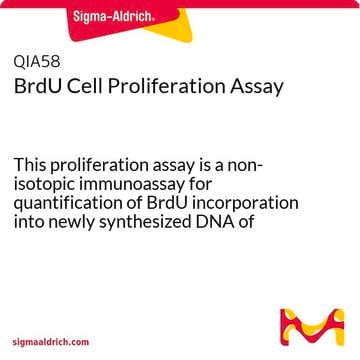11299964001
Roche
5-Bromo-2′-deoxy-uridine Labeling and Detection Kit II
sufficient for ≤100 tests, storage temp.:-20°C
Sinónimos:
5-BrdU, 5-Bromo-2-deoxyuridine
About This Item
Productos recomendados
General description
Alternatively, 5-bromo-2′-deoxy-uridine (BrdU) may be used instead of thymidine. Cells that have incorporated BrdU into DNA are easily detected using a monoclonal antibody against BrdU and an enzyme- or fluorochrome-conjugated second antibody.
Specificity
Application
- labeling of tooth roots for histology
- immunostaining of mice frontal sections
- immunofluorescence imaging of hepatocellular carcinoma sections
Features and Benefits
- Safe: No radioisotopes are used.
- Easy to perform: Follows a standard immunohistochemistry protocol.
- Sensitive: Denaturation of DNA with nucleases allows for highly sensitive detection of BrdU.
- Flexible: Allows double-labeling protocols.
Packaging
Principle
Preparation Note
Sample material:
Cell culture: adherent cells, suspension cells, organ or explant cultures. Frozen or paraffin-embedded tissue sections (after in vivo labeling).
Other Notes
Solo componentes del kit
- BrdU Labeling Reagent 1,000x concentrated
- Washing Buffer concentrate 10x concentrated
- Incubation Buffer
- Anti-BrdU antibody, contains nucleases for DNA denaturation
- Anti-mouse Ig-alkaline Phosphatase antibody
- NBT
- BCIP
signalword
Danger
Hazard Classifications
Acute Tox. 4 - Acute Tox. 4 Inhalation - Eye Irrit. 2 - Flam. Liq. 3 Dermal - Muta. 1B - Repr. 1B - Skin Sens. 1
Storage Class
3 - Flammable liquids
wgk_germany
WGK 2
flash_point_f
136.4 °F
flash_point_c
58 °C
Certificados de análisis (COA)
Busque Certificados de análisis (COA) introduciendo el número de lote del producto. Los números de lote se encuentran en la etiqueta del producto después de las palabras «Lot» o «Batch»
¿Ya tiene este producto?
Encuentre la documentación para los productos que ha comprado recientemente en la Biblioteca de documentos.
Los clientes también vieron
Artículos
Cell based assays for cell proliferation (BrdU, MTT, WST1), cell viability and cytotoxicity experiments for applications in cancer, neuroscience and stem cell research.
Cell based assays for cell proliferation (BrdU, MTT, WST1), cell viability and cytotoxicity experiments for applications in cancer, neuroscience and stem cell research.
Cell based assays for cell proliferation (BrdU, MTT, WST1), cell viability and cytotoxicity experiments for applications in cancer, neuroscience and stem cell research.
Cell based assays for cell proliferation (BrdU, MTT, WST1), cell viability and cytotoxicity experiments for applications in cancer, neuroscience and stem cell research.
Nuestro equipo de científicos tiene experiencia en todas las áreas de investigación: Ciencias de la vida, Ciencia de los materiales, Síntesis química, Cromatografía, Analítica y muchas otras.
Póngase en contacto con el Servicio técnico













